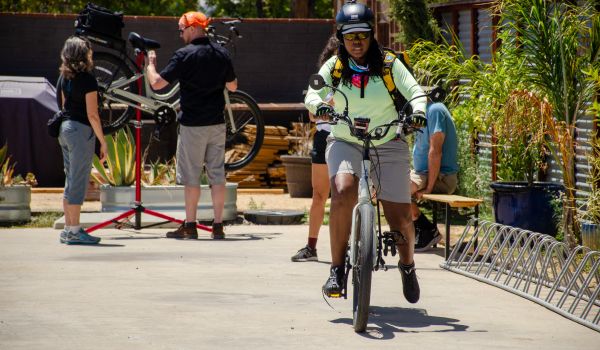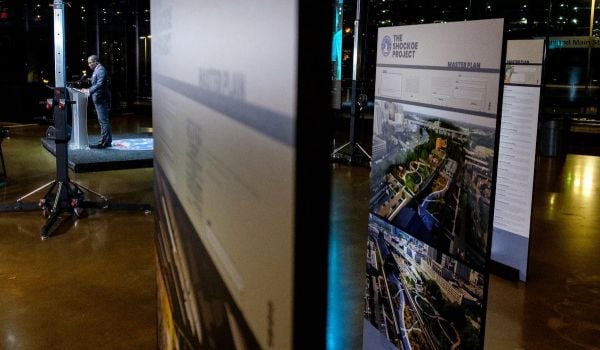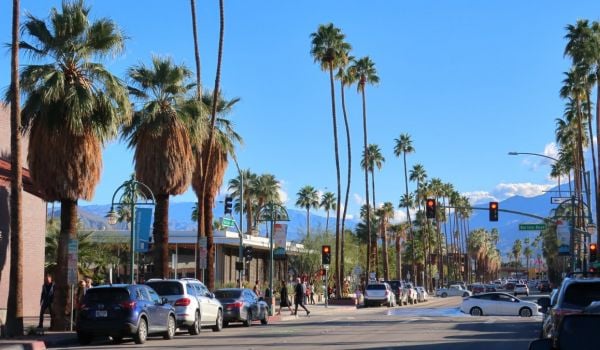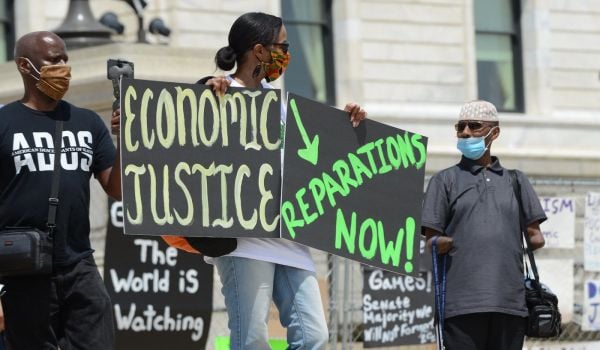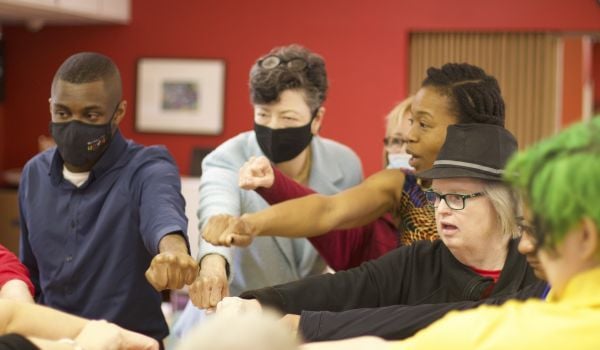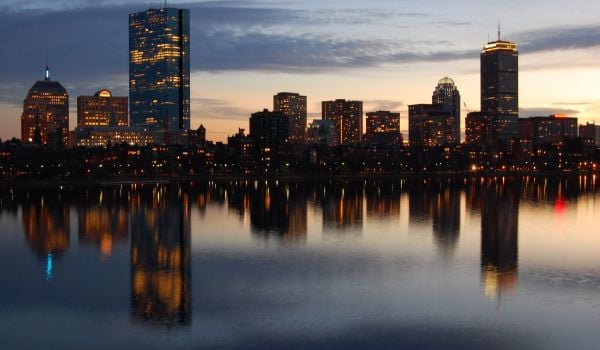This story was originally published at Prism.
On any given day, Chicano Park in San Diego is filled with families and gleeful children enjoying its grassy picnic areas, playgrounds, and sports areas, including a concrete skate park. Nestled under the transition ramps between Interstate 5 and the foot of the San Diego-Coronado Bridge in the historically Mexican-American working-class community of Barrio Logan, the park not only represents neighborhood’s vitality, it’s also a visible testament to a decades-old legacy of resistance against dislocation and displacement that has not only shaped the character of the surrounding community, but also forever changed its trajectory.
Fifty-two years ago on April 22, 1970, Barrio residents, alongside a coalition comprised of hundreds of students, community activists, Brown Berets, and Movimiento Estudiantil Chicano de Aztlán (MEChA) collectively staged a successful 12-day people’s land takeover to thwart the construction of a California Highway Patrol substation on land where the city of San Diego had promised to build a public park for barrio residents. Thanks in part to the protest, the city of San Diego agreed to acquire the site from the state and develop it into a park for the Chicano community.
Today Chicano Park is widely regarded as a monument to the self-determination and self-empowerment of Chicano people in the U.S. The concrete pillars that uphold the Coronado Bridge that once sliced and divided the community are now adorned with the iconic murals that have made Chicano Park an anchor for the community’s strong Chicano identity and its revolutionary spirit and history.
But while Chicano Park has grown and expanded alongside the neighborhood and received a National Historic Landmark designation from the U.S. Department of the Interior in 2017, the park and its illustrious collection of intricate murals continued to lack an official space dedicated to documentation and preservation of its history. Most recently on Oct. 8, Chicano Park opened the Chicano Park Museum and Cultural Center (CPMCC).
Organizers and community members hope the museum will document the history of Chicano Park and continue educating future generations about Barrio Logan’s history. For many, the successful opening of the CPMCC encapsulates the neighborhood’s long legacy of community organizing and self-determination to successfully overcome institutional forces that historically have attempted to relegate the barrio and its residents to what many would consider second citizenry.
A challenging road to realization
For years, the Chicano Park Steering Committee (CPSC) maintained a map of the park’s murals on its website, along with information about the artwork and the muralists. Every year thousands of visitors come to Chicano Park, and it’s not uncommon to see a tour bus or local schools in the park on field trips. However, for much of its existence Chicano Park had no welcome center or facility where visitors could learn more about the park’s history and its vast outdoor murals. Like the creation of Chicano Park itself, the road to obtaining a space for a museum dedicated to the park and the surrounding neighborhood’s history has been a long and fraught process.
The CPSC saw its window of opportunity open in 2015 when the 9,890-square-foot brick building immediately adjacent to the north side of the park was vacated by the San Diego Community College District (SDCC). However, their efforts date back to the park’s founding itself—in fact, that building was initially part of the takeover and negotiation for LANDBACK in 1970. For nearly a decade, it was used for various social services, and while under the CPSC’s control in the 1970s it was used as office space for the Chicano Federation, a nonprofit organization that provides early childhood education, a child nutrition program, and affordable housing opportunities for seniors, families, and disabled people.
In 1980, after Chicano Federation relocated, the CPSC allowed the building to be leased by the SDCC to house the Cesar Chavez Continuing Education Center, an adult education school. Advocates claim that the community widely understood that the lease would be a short-term arrangement, while another permanent school was built at another location. However, the new campus wasn’t completed until 2015, nearly 35 years later.
The CPSC resumed lease conversations with the city in 2015, advocating for the fulfillment of its promise to lease the city-owned building inside park boundaries without opening it up to other bids. After several years of negotiations and meticulous meetings with city council members, in 2018, the San Diego City Council unanimously approved a 20-year lease for the CPMCC.
For Lucas Cruz, the current chairman of CPSC and its community development subcommittee, the CPMCC’s opening is the culmination of a years-long effort from many different organizers and community members who have stuck through the long, arduous, and frustrating process of negotiating with city officials, fundraising for the facility’s renovations, and keeping public awareness and support for the museum alive and continually at the forefront of the community’s collective consciousness.
“It’s been a slow process and a long time coming, but it’s exciting to have the history all there, where we can point people to it now,” Cruz said. “People can see photos of the takeover and know that this really happened. When you see the photos, the film, and all the documentation, it hits you a lot differently.”
Efforts to lease and renovate the building into the CPMCC were largely spearheaded by Josephine Talamantez, a CPSC member, an original co-founder of Chicano Park, and the chairwoman of the CPMCC. In 1970, Talamantez was an 18-year-old attending San Diego City College and part of MEChA when she took part in the land occupation and helped form the CPSC. Talamantez also did much of the leg work to achieve Chicano Park’s landmark status. As chairwoman of the CPMCC she vigorously lobbied the San Diego City Council to lease the building and procured donations to renovate the building’s interior.
In a video posted on the CPSC’s official YouTube Channel, Talamantez stresses the importance of the museum and the history’s relevance to today’s moment: “I think that it’s important to educate the people at large because you hear a lot of times the ‘era of the Chicano Movement.’ And I’m thinking, ’When did the ‘era’ of the Chicano Movement ever end?’ I’m still Chicana, I’m still alive … Chicano Park and the monumental murals are still in place. We are not historical artifacts, we are still living today.”
Providing access to history
For Cruz, opening the CPMCC is a long-time familial dream finally realized. Much of the material featured in the museum’s exhibits was taken directly from the personal collection of Cruz’s grandmother Tommie Camarillo, an original Chicano Park co-founder and longtime former chairwoman of the CPSC. For decades, Camarillo meticulously archived virtually everything related, from legal documents, photographs, and newspaper articles, to old flyers, pins, and posters of past park events. Without any dedicated space to safely store and display these items, Camarillo would schedule appointments for visitors to come to her home to look through archival materials.
“We needed a museum because of the need to tell the story of multiple families who have been a part of the park’s history,” Camarillo said.
Cruz, Camarillo, Talamantez, and other volunteers on the CPMCC’s board have spent years meticulously pouring over an extensive archive of photos, home videos, news clippings, and oral stories collected from members of the community that document the history of Chicano Park and Barrio Logan. As a precursor to the museum’s grand opening, Cruz helped curate a mini-exhibit at Aztlán Libre, a community space, shop, and gallery down the street from Chicano Park.
“[Access to the archives] allows people to learn what really happened [and] an opportunity to share the history with the park’s visitors and help students look toward the potential future,” Camarillo said. “I would spend hours with visitors in the park sharing the history, so it will be nice to be able to point them to the museum’s archives. All the work that we have done will be on display.”
The museum’s inaugural exhibition, “P.I.L.L.A.R.S.: People In Lucha y Liberación And Resilient Struggle,” will premiere a collective historical narrative documenting both Chicano Park and the surrounding Logan Heights area. It will feature 13 miniature Chicano Park pillars highlighting elements at the heart of the Chicano Park Movement, such as local community organizations and institutions. Cruz hopes that the cultural center portion of the museum can also be used for other community activities, such as Danza Azteca and Baile folklórico practices, and utilizing the building’s kitchen facilities for other programs like the CPSC Youth Lunch Distribution Program.
There will also be an installation by artist Salvador “Queso” Torres, one of Chicano Park’s original muralists. For Torres, the museum’s importance of creating lies in its ability to showcase the struggles and triumphs of a community that has managed to thrive despite enduring decades of neglect and institutional racism.
“We are presenting our victorious, triumphant accomplishments by a community that has not died,” Torres said. “Regardless of I-5 freeway destruction of our homes and the commercial district, and the monstrous, monumental San Diego-Coronado Bridge, Barrio Logan has persevered and thrived.”
The opening of the CPMCC marks a new chapter in Chicano Park’s history, one that continues a tradition of self-determination as the community reclaims the ability to preserve and share its own history. Cruz hopes that sharing the history of Chicano Park will show visitors that sustained collective action can create change. While the murals are a common focus for many in the park, Cruz said it’s just as important to highlight the revolutionary history behind the site.
“Documenting and archiving our history is critical because we have so few spaces that are ours, but the Chicano Park museum is ours,” Cruz said. “We know it’s ours because it’s right there in the name. We want people to come away seeing that there’s always potential for change in their communities as well.
Roberto Camacho is a Chicano freelance multimedia journalist from San Diego, California. His reporting typically focuses on criminal justice reform, immigration, Chicano/Latino issues, hip-hop culture, and their intersections to social justice.

_920_685_80.jpg)
